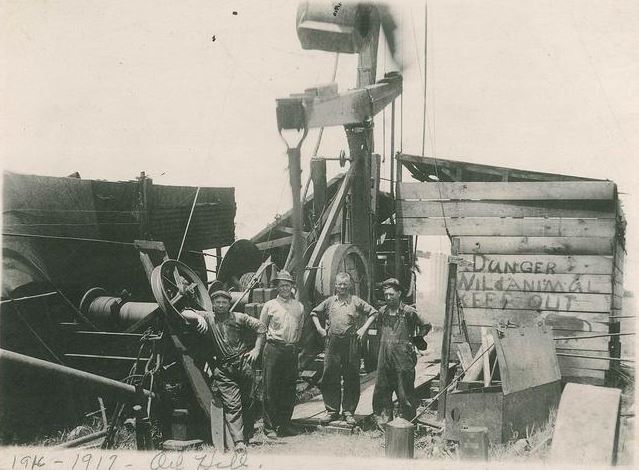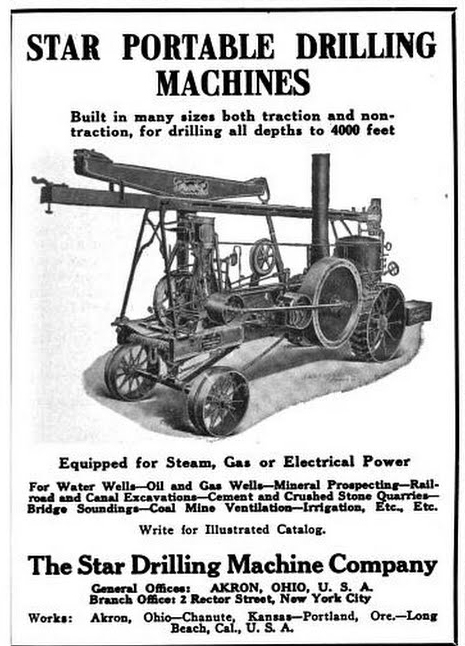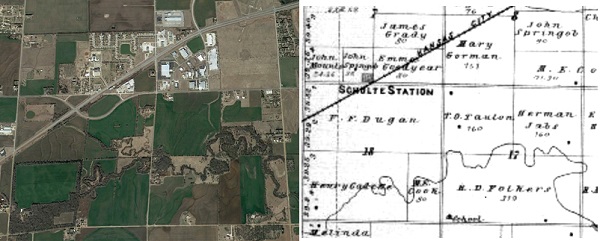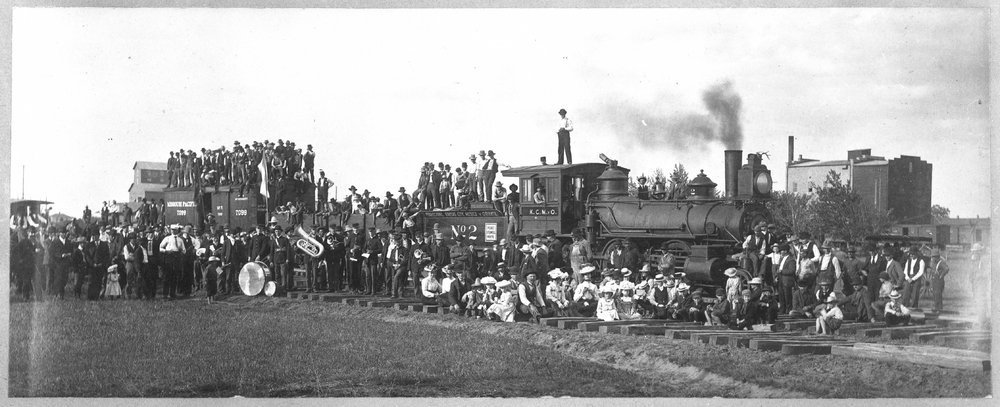Searching for petroleum wealth in risky Mid-Continent fields.
The Kansas petroleum industry began in 1892 with an oilfield at Neodesha. In 1915, an oilfield discovery at El Dorado near Wichita revealed the giant Mid-Continent field, but it took years for business sense to arrive, according to the editor of a 1910 History of Wichita and Sedgwick County, Kansas.

The new science of petroleum geology helped reveal the Mid-Continent’s giant El Dorado oilfield in 1915. Photo courtesy Kansas Oil Museum.
“Sedgwick county has run the gamut of the hot winds, the drought, the floods, the grasshoppers, the boom, the wild unreasoning era of speculation, the land grafters, the oil grafters, the sellers of bogus stocks, speculation, over-capitalization, and all of the attendant and kindred evils,” observed Editor-in-Chief Orsemus Bentley.
Bentley added that from all the scourges, Kansans “emerged into the clear noon-day of reason, out of a fool’s paradise into business sense.”
Although Wichita and Sedgwick County’s economies would remain dependent on farming and ranching, the age of oil soon began. In 1915, the Wichita Natural Gas Company, a subsidiary of Cities Service Company, drilled with a cable-tool rig on the John Stapleton farm northeast of town. The company’s Stapleton No. 1 exploratory well (at a site chosen using the emerging science of petroleum geology) struck oil and launched a true Kansas boom.

Early 20th century portable drilling rigs used cable-tools and could be powered by steam, gasoline, or electricity.
“Day after day the tools stomped their way into the solid earth until a depth of 670 feet oil was discovered,” explains a historian in neighboring Butler County. “Word spread like a wind-whipped prairie fire and the black gold rush was on.”
Wichita Oil & Gas Company
Just a few months after the Stapleton well, Wichita Oil & Gas Company began drilling its first exploratory well on January 8, 1916. The Wichita Eagle reported company capitalization to be $100,000 with stock for sale at par value of $1.10 a share, adding the company would be “ready to start work on a derrick next week.”
Wichita Oil & Gas’ drilling fortunes depended on a portable Star Drilling Machine, a cable-tool drilling technology. The company leased land south of Wichita – just southeast of the Kansas City, Mexico and Orient Railroad station at Schulte, Kansas.
Despite claims of a “2,000 acre lease around the town,” all Wichita Oil & Gas drilling would take place within a 500-foot radius of a spot on the 319-acre Folkers farm (Section 17, Township 28 South, Range 1 East). After months of drilling, the company updated investors in November 1916.
“Peter Schulte was up from the town Schulte today and reported the oil well near there progressing nicely,” the company reported. “The drill is now down over 1,400 feet and far as can be judged at this stage, the drilling prospects for a strike are good.”


Wichita Oil & Gas Company drilled southeast of the train station at Schulte, Kansas, in 1916. About 50 miles away, citizens of Anthony had gathered in 1902 to celebrate the driving of the first spike on the Kansas City, Mexico & Orient Railway. Photo courtesy Kansas Historical Society.
The exploration company further assured investors, “The field is entirely new of course and no one can tell what may be discovered. If oil or gas found here it will put Wichita oil the map.”
For “poor boy” companies with limited capitalization like Wichita Oil & Gas, the costs of continued drilling were often financed through increased stock sales and hyperbole. Accurate newspaper accounts were rare. One Wichita Oil & Gas executive appealed to potential investors on Christmas Eve in 1916.
After declaring that the company stock had been selling for $10 per share, Secretary-Treasurer A.L. Tuttle predicted it would advance to $15 per share. “This is the company that has been drilling the well at Schulte,” he noted. “We are down 1,400 feet.”
But when its well failed to find oil, the company relocated the cable-tool rig and tried again nearby. This well, the Folkers No. A 1, was plugged and abandoned after reaching a depth of 1,404 feet. The search for investors and loans continued even as drilling reports from the company began to dwindle. A decline in stock sales and financing woes may help explain the intermittent reporting.
Ultimately, the Kansas Attorney General launched a suit against Wichita Oil & Gas Company. The American Gas Engineering Journal of September 7, 1918, reported the state was seeking a receiver for Wichita Oil & Gas with action “brought against the company, the directors and against each director individually.”
The suit also noted the drilling the last well: “A Star Rig was used, and when the company ran short of finances the depth was approximately 1,400 feet.”
It was the end of Wichita Oil & Gas Company, although the Kansas Geological Survey reported the Folkers farm well site drew new drilling activity even after the company had failed. White Oil Corporation drilled a well 3,400 feet deep not far from the last dry hole drilled by Wichita Oil & Gas, but found no oil.
Few newly formed, inexperienced petroleum exploration companies would succeed in the risky Mid-Continent fields, including the Otter Creek Oil & Gas Company, formed by three Wichita businessmen.
Oil fever also reached southeastern Kansas, where Missouri investors saw opportunities in 1904 and organized the Cahege Oil & Gas Company. Two years later, the boom town of Caney made headlines — and attracted tourists with a Kansas gas well fire that at night could be seen for miles.
More stories of exploration and production companies trying to join petroleum booms (and avoid busts) can be found updated in Is my Old Oil Stock worth Anything?
_______________________
Recommended Reading: The fire in the rock: A history of the oil and gas industry in Kansas (1976); History of Paola, Kansas (1956); Caney, Kansas: The Big Gas City (1985). Your Amazon purchase benefits the American Oil & Gas Historical Society. As an Amazon Associate, AOGHS earns a commission from qualifying purchases.
_______________________
The American Oil & Gas Historical Society (AOGHS) preserves U.S. petroleum history. Please become an annual AOGHS supporter and help maintain this energy education website and expand historical research. For more information, contact bawells@aoghs.org. Copyright © 2024 Bruce A. Wells. All rights reserved.
Citation Information – Article Title: “Wichita Oil & Gas Company.” Authors: B.A. Wells and K.L. Wells. Website Name: American Oil & Gas Historical Society. URL: https://aoghs.org/oil-almanac/wichita-oil-gas-company. Last Updated: August 2, 2024. Original Published Date: August 15, 2016.



